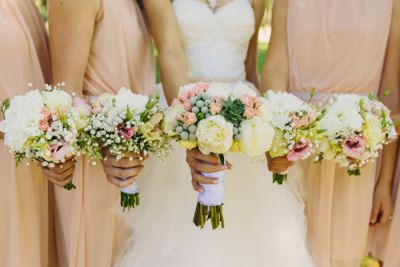 Many wedding experts suggest selecting seasonal wedding flowers for bouquets, décor, boutonnieres, and other arrangements. There’s quite a lot of sound reasoning behind this advice, since buying local slashes down your total costs. With more couples hosting rustic and bohemian weddings, demand for seasonal blooms has increased thanks to their natural beauty. If you want to take advantage of these benefits, you’ll need to strategically plan your event and know the varieties of flora that are available in your region.
Many wedding experts suggest selecting seasonal wedding flowers for bouquets, décor, boutonnieres, and other arrangements. There’s quite a lot of sound reasoning behind this advice, since buying local slashes down your total costs. With more couples hosting rustic and bohemian weddings, demand for seasonal blooms has increased thanks to their natural beauty. If you want to take advantage of these benefits, you’ll need to strategically plan your event and know the varieties of flora that are available in your region.
The Case for Seasonal Local Blossoms
Seasonal local flowers price out less than their more expensive counterparts for a couple of reasons. The Knot explains that their storage and transportation costs can be considerably lower. Not only that, you enjoy the side benefit of getting the freshest blooms possible. The Knot’s Tia Albright also suggests sourcing your wedding flowers from farm-to-table vendors, which make your wedding more sustainable and reduce your carbon footprint in two ways:
- These companies raise organic blooms without using harmful chemicals.
- They promote fair labor practices in growing, harvesting, and preparing their flowers.
Also, consider incorporating potted plants or topiaries in your décor. These can work especially well as centerpieces or decorations in key areas such as your gift and cake tables. For the latter, be sure to select varieties that do not pose an illness risk if accidentally ingested.
Is Your Favorite Flower an Optimal Choice?
When asked to picture a wedding in their minds, many individuals may think of a church or ballroom festooned with roses, orchids, tulips, or hydrangeas. That’s no surprise, given that these four flowers appear in Brides writer Hannah Baker’s list of the ten most perennially popular varieties. The Knot also mentions calla lilies, gardenias, peonies, and stephanotis blossoms.
Fortunately, The Spruce’s Nina Callaway provides a handy guide for selecting seasonal varieties. Rose lovers are in luck, since their favorites are readily obtainable during the entire year. Orchids are also available year-round, as well as calla lilies and gardenias. Tulips and peonies primarily bloom in the spring while stephanotis and hydrangeas are mostly summer-appropriate picks. Wedding Wire’s Alex Reardon lists even more that your florist may be easily able to source at any time.
Callaway’s guide is a great resource, especially if your date’s already set and you want to stick to in-season arrangements. However, she cautions that those tying the knot in February should expect to pay more due to the Valentine’s Day demand.
Buy Local and Save Even More
Of course, you can also maximize your savings by choosing locally grown flowers. An archived Martha Stewart Weddings piece mentions varieties that are typically produced in every United States region during each season. While this list includes the usual commercially raised favorites, remember that local wildflowers and greenery also offer some beautiful possibilities.
Consider These Other Budget-Friendly Tips
Some commonly overlooked flowers can produce stunning results when included in wedding décor. In her article for The Spruce, Callaway explains how skilled florists incorporate budget blooms like carnations, chrysanthemums, and baby’s breath, especially in monochromatic or bold colorful arrangements. On the other hand, you don’t need to completely write off the idea of using statement blooms. Used sparingly as star players mixed in with less expensive complementary species, these premium-quality flowers lend an air of elegance and sophistication.
When chosen wisely, wedding flowers can complement nearly any style. The good news is that you don’t have to clean out your wallet to pull off a beautiful, cohesive look. Seasonal and locally sourced varieties present plenty of gorgeous options without breaking the bank. Doing your homework, collaborating with your florist, and keeping an open mind are all wise ways to decorate your spaces and outfit your wedding party while lowering your event’s price tag.
Add Your Comment